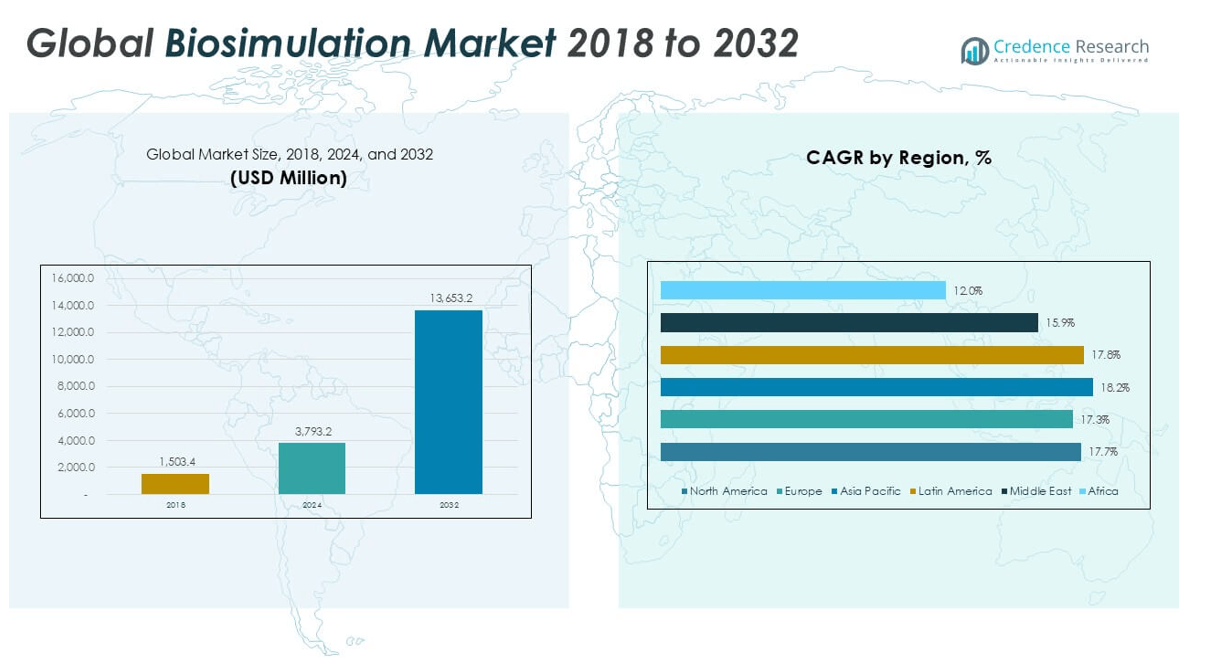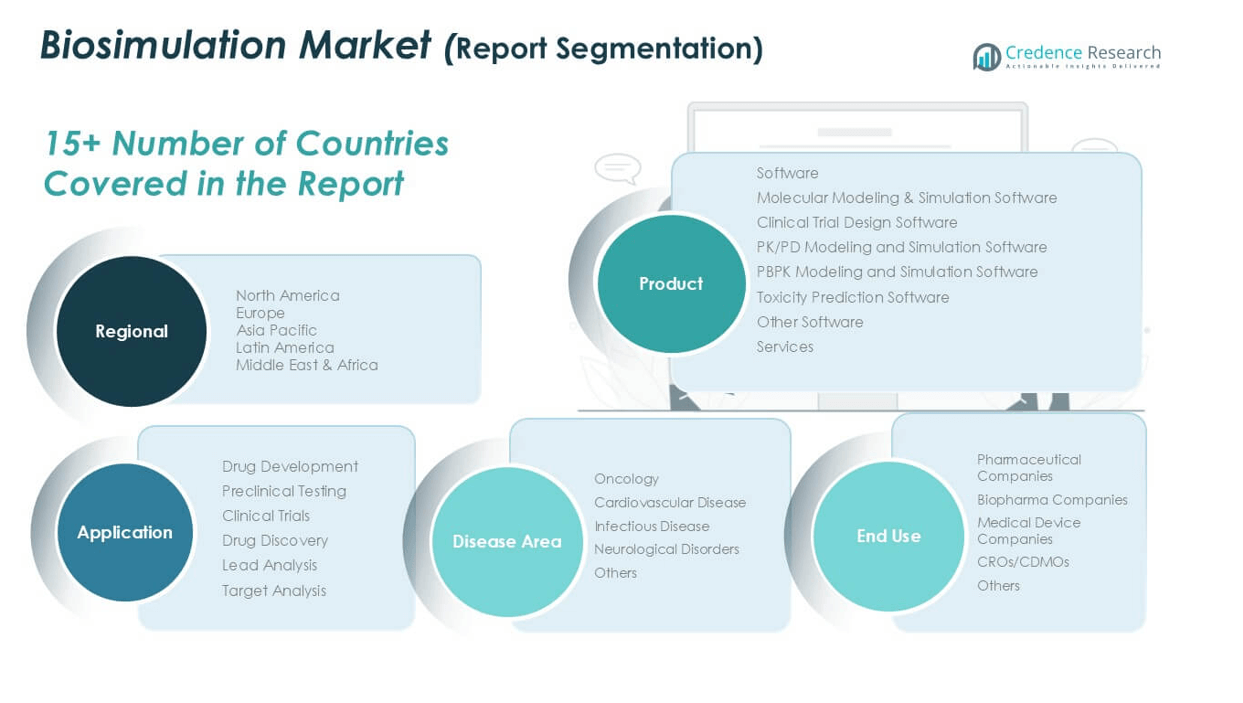CHAPTER NO. 1 : GENESIS OF THE MARKET
1.1 Market Prelude – Introduction & Scope
1.2 The Big Picture – Objectives & Vision
1.3 Strategic Edge – Unique Value Proposition
1.4 Stakeholder Compass – Key Beneficiaries
CHAPTER NO. 2 : EXECUTIVE LENS
2.1 Pulse of the Industry – Market Snapshot
2.2 Growth Arc – Revenue Projections (USD Million)
2.3. Premium Insights – Based on Primary Interviews
CHAPTER NO. 3 : BIOSIMULATION MARKET FORCES & INDUSTRY PULSE
3.1 Foundations of Change – Market Overview
3.2 Catalysts of Expansion – Key Market Drivers
3.2.1 Momentum Boosters – Growth Triggers
3.2.2 Innovation Fuel – Disruptive Technologies
3.3 Headwinds & Crosswinds – Market Restraints
3.3.1 Regulatory Tides – Compliance Challenges
3.3.2 Economic Frictions – Inflationary Pressures
3.4 Untapped Horizons – Growth Potential & Opportunities
3.5 Strategic Navigation – Industry Frameworks
3.5.1 Market Equilibrium – Porter’s Five Forces
3.5.2 Ecosystem Dynamics – Value Chain Analysis
3.5.3 Macro Forces – PESTEL Breakdown
3.6 Price Trend Analysis
3.6.1 Regional Price Trend
3.6.2 Price Trend By Product
CHAPTER NO. 4 : KEY INVESTMENT EPICENTER
4.1 Regional Goldmines – High-Growth Geographies
4.2 Product Frontiers – Lucrative Product Categories
4.3 Disease Area Sweet Spots – Emerging Demand Segments
CHAPTER NO. 5: REVENUE TRAJECTORY & WEALTH MAPPING
5.1 Momentum Metrics – Forecast & Growth Curves
5.2 Regional Revenue Footprint – Market Share Insights
5.3 Segmental Wealth Flow – Product, Application, Disease Area, & End User Revenue
CHAPTER NO. 6 : TRADE & COMMERCE ANALYSIS
6.1. Import Analysis By Region
6.1.1. Global Biosimulation Market Import Revenue By Region
6.2. Export Analysis By Region
6.2.1. Global Biosimulation Market Export Revenue By Region
CHAPTER NO. 7 : COMPETITION ANALYSIS
7.1. Company Market Share Analysis
7.1.1. Global Biosimulation Market: Company Market Share
7.2. Global Biosimulation Market Company Revenue Market Share
7.3. Strategic Developments
7.3.1. Acquisitions & Mergers
7.3.2. New Product Launch
7.3.3. Regional Expansion
7.4. Competitive Dashboard
7.5. Company Assessment Metrics, 2024
CHAPTER NO. 8 : BIOSIMULATION MARKET – BY PRODUCT SEGMENT ANALYSIS
8.1. Biosimulation Market Overview By Product Segment
8.1.1. Biosimulation Market Revenue Share By Product
8.2. Software
8.2.1. Molecular Modeling & Simulation Software
8.2.2. Clinical Trial Design Software
8.2.3. PK/PD Modeling and Simulation Software
8.2.4. PBPK Modeling and Simulation Software
8.2.5. Toxicity Prediction Software
8.2.6. Other Software
8.3. Services
CHAPTER NO. 9 : BIOSIMULATION MARKET – BY APPLICATION SEGMENT ANALYSIS
9.1. Biosimulation Market Overview By Application Segment
9.1.1. Biosimulation Market Revenue Share By Application
9.2. Drug Development
9.2.1. Preclinical Testing
9.2.2. Clinical Trials
9.3. Drug Discovery
9.3.1. Lead Analysis
9.3.2. Target Analysis
CHAPTER NO. 10 : BIOSIMULATION MARKET – BY DISEASE AREA SEGMENT ANALYSIS
10.1. Biosimulation Market Overview By Disease Area Segment
10.1.1. Biosimulation Market Revenue Share By Disease Area
10.2. Oncology
10.3. Cardiovascular Disease
10.4. Infectious Disease
10.5. Neurological Disorders
10.6. Others
CHAPTER NO. 11 : BIOSIMULATION MARKET – BY END USER SEGMENT ANALYSIS
11.1. Biosimulation Market Overview By End User Segment
11.1.1. Biosimulation Market Revenue Share By End User
11.2. Pharmaceutical Companies
11.3. Biopharma Companies
11.4. Medical Device Companies
11.5. CROs/CDMOs
11.6. Others
11.4. Contract Research Organizations
CHAPTER NO. 12 : BIOSIMULATION MARKET – REGIONAL ANALYSIS
12.1. Biosimulation Market Overview By Region Segment
12.1.1. Global Biosimulation Market Revenue Share By Region
12.1.2. Regions
12.1.3. Global Biosimulation Market Revenue By Region
12.1.4. Product
12.1.5. Global Biosimulation Market Revenue By Product
12.1.6. Application
12.1.7. Global Biosimulation Market Revenue By Application
12.1.8. Disease Area
12.1.9. Global Biosimulation Market Revenue By Disease Area
12.1.10. End User
12.1.11. Global Biosimulation Market Revenue By End User
CHAPTER NO. 13 : NORTH AMERICA BIOSIMULATION MARKET – COUNTRY ANALYSIS
13.1. North America Biosimulation Market Overview By Country Segment
13.1.1. North America Biosimulation Market Revenue Share By Region
13.2. North America
13.2.1. North America Biosimulation Market Revenue By Country
13.2.2. Product
13.2.3. North America Biosimulation Market Revenue By Product
13.2.4. Application
13.2.5. North America Biosimulation Market Revenue By Application
13.2.6. Disease Area
13.2.7. North America Biosimulation Market Revenue By Disease Area
13.2.8. End User
13.2.9. North America Biosimulation Market Revenue By End User
13.3. U.S.
13.4. Canada
13.5. Mexico
CHAPTER NO. 14 : EUROPE BIOSIMULATION MARKET – COUNTRY ANALYSIS
14.1. Europe Biosimulation Market Overview By Country Segment
14.1.1. Europe Biosimulation Market Revenue Share By Region
14.2. Europe
14.2.1. Europe Biosimulation Market Revenue By Country
14.2.2. Product
14.2.3. Europe Biosimulation Market Revenue By Product
14.2.4. Application
14.2.5. Europe Biosimulation Market Revenue By Application
14.2.6. Disease Area
14.2.7. Europe Biosimulation Market Revenue By Disease Area
14.2.8. End User
14.2.9. Europe Biosimulation Market Revenue By End User
14.3. UK
14.4. France
14.5. Germany
14.6. Italy
14.7. Spain
14.8. Russia
14.9. Rest of Europe
CHAPTER NO. 15 : ASIA PACIFIC BIOSIMULATION MARKET – COUNTRY ANALYSIS
15.1. Asia Pacific Biosimulation Market Overview By Country Segment
15.1.1. Asia Pacific Biosimulation Market Revenue Share By Region
15.2. Asia Pacific
15.2.1. Asia Pacific Biosimulation Market Revenue By Country
15.2.2. Product
15.2.3. Asia Pacific Biosimulation Market Revenue By Product
15.2.4. Application
15.2.5. Asia Pacific Biosimulation Market Revenue By Application
15.2.6. Disease Area
15.2.7. Asia Pacific Biosimulation Market Revenue By Disease Area
15.2.8. End User
15.2.9. Asia Pacific Biosimulation Market Revenue By End User
15.3. China
15.4. Japan
15.5. South Korea
15.6. India
15.7. Australia
15.8. Southeast Asia
15.9. Rest of Asia Pacific
CHAPTER NO. 16 : LATIN AMERICA BIOSIMULATION MARKET – COUNTRY ANALYSIS
16.1. Latin America Biosimulation Market Overview By Country Segment
16.1.1. Latin America Biosimulation Market Revenue Share By Region
16.2. Latin America
16.2.1. Latin America Biosimulation Market Revenue By Country
16.2.2. Product
16.2.3. Latin America Biosimulation Market Revenue By Product
16.2.4. Application
16.2.5. Latin America Biosimulation Market Revenue By Application
16.2.6. Disease Area
16.2.7. Latin America Biosimulation Market Revenue By Disease Area
16.2.8. End User
16.2.9. Latin America Biosimulation Market Revenue By End User
16.3. Brazil
16.4. Argentina
16.5. Rest of Latin America
CHAPTER NO. 17 : MIDDLE EAST BIOSIMULATION MARKET – COUNTRY ANALYSIS
17.1. Middle East Biosimulation Market Overview By Country Segment
17.1.1. Middle East Biosimulation Market Revenue Share By Region
17.2. Middle East
17.2.1. Middle East Biosimulation Market Revenue By Country
17.2.2. Product
17.2.3. Middle East Biosimulation Market Revenue By Product
17.2.4. Application
17.2.5. Middle East Biosimulation Market Revenue By Application
17.2.6. Disease Area
17.2.7. Middle East Biosimulation Market Revenue By Disease Area
17.2.8. End User
17.2.9. Middle East Biosimulation Market Revenue By End User
17.3. GCC Countries
17.4. Israel
17.5. Turkey
17.6. Rest of Middle East
CHAPTER NO. 18 : AFRICA BIOSIMULATION MARKET – COUNTRY ANALYSIS
18.1. Africa Biosimulation Market Overview By Country Segment
18.1.1. Africa Biosimulation Market Revenue Share By Region
18.2. Africa
18.2.1. Africa Biosimulation Market Revenue By Country
18.2.2. Product
18.2.3. Africa Biosimulation Market Revenue By Product
18.2.4. Application
18.2.5. Africa Biosimulation Market Revenue By Application
18.2.6. Disease Area
18.2.7. Africa Biosimulation Market Revenue By Disease Area
18.2.8. End User
18.2.9. Africa Biosimulation Market Revenue By End User
18.3. South Africa
18.4. Egypt
18.5. Rest of Africa
CHAPTER NO. 19 : COMPANY PROFILES
19.1. Dassault Systems SA
19.1.1. Company Overview
19.1.2. Product Portfolio
19.1.3. Financial Overview
19.1.4. Recent Developments
19.1.5. Growth Strategy
19.1.6. SWOT Analysis
19.2. Schrodinger, Inc.
19.3. Advanced Chemistry Development, Inc.
19.4. Chemical Computing Group, Inc.
19.5. Physiomics PLC
19.6. Entelos, Inc.,
19.7. Rhenovia Pharma Ltd
19.8. Genedata AG
19.9. Instem Group of Companies
19.10. PPD, Inc.
19.11. Other Key Palyers






